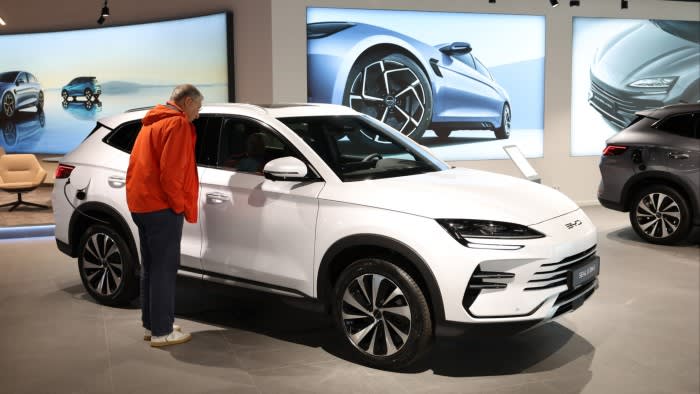Stay informed with free updates
Simply sign up to the Electric vehicles myFT Digest — delivered directly to your inbox.
The existential threat posed by China to Japan’s auto industry finally began to manifest last year. BYD, China’s electric car champion, jumped to number seven in global rankings for car sales, surpassing Honda and Nissan for the first time, according to automotive industry data provider, MarkLines.
With Japan’s number two and three in the rear-view mirror, Shenzhen-based BYD now has its sights set on the biggest of them all in the car sector: Toyota.
The seismic shift from combustion engines to electric motors and the breakneck speed of the rise of China’s electric vehicle industry poses serious challenges to Japan’s auto industry, a cornerstone of the economy.
Investors in Japan’s automakers must take a view on the future direction of the electric car market.
Some believe insufficient battery charging infrastructure and rapid depreciation in the price of EVs after the initial purchase might slow down electric car sales growth. Investors who believe EVs face those barriers are bullish on a bright future for full hybrids such as Toyota’s.
“Global [full] hybrid sales were 6.6mn last year out of the total market of 95mn units. There’s a huge opportunity for Japanese automakers to gain market share,” says Kota Yuzawa, an auto analyst at Goldman Sachs. “It’s a fairly protected growth industry for the foreseeable future. Plug-in hybrid is 6.2mn, EV is 10.6mn and internal combustion engine is 71.7mn.”
On the bearish side are those betting that the high-tech EV and software revolution will move forward at pace and the world will imitate China where almost half of annual car sales in 2024 were electric models, compared with about 20 per cent in the EU and 10 per cent in the US, according to the International Energy Agency.
Toyota and its Japanese peers have been slow to put high-tech EVs similar to those provided by BYD on the market, creating doubts over whether they can ever catch up. Auto industry insiders see a fundamental problem in the development speed for new models, which Masato Shoji, partner at Deloitte Tohmatsu in Tokyo, estimates to be six to seven years for Japan’s car producers compared with 18 months for some Chinese peers.
“Looking at it over the timescale of the next 10 years, I see Japanese automakers being pushed into a very difficult situation,” says Manabu Hirai, leader of the automotive unit at Deloitte Tohmatsu. “I get the sense that it’s a trend of being chipped away bit by bit, competitiveness falling and momentum not being there.”
Japan’s car producers — excluding Toyota, which has maintained robust sales in China — have suffered steep declines in numbers of vehicles sold in China since 2020, company filings show.
The next big battleground is south-east Asia. In six of south-east Asia’s biggest car markets, competition from China has been intense as Japanese auto groups’ market share dropped from 73 per cent in 2021 to 64 per cent in 2024, according to consultancy PwC.
A swing factor in the fight for south-east Asia, say analysts, will be how attractive EVs remain when subsidies decrease, as widely anticipated, and whether electric models can hold their price in the used vehicle market.
However, Japan’s automakers do have stable regions of refuge protected from Chinese competition: the US, India and their home market.
Japanese car producers face a headwind from Trump’s tariffs of 15 per cent on auto exports from their home base to the US. But in reality, the blow has been mitigated by the weak yen, which makes Japanese exports more affordable, and decades of investment in North American supply chains. US hybrid purchases also have strong momentum behind them, especially as the Trump administration cuts EV subsidies.
India could also provide growth, as rising middle classes graduate from riding motorbikes to driving cars.
Despite intensifying global competition, Toyota has consistently been the auto industry’s most profitable company and generates huge cash piles to transform itself and bet on multiple technologies. Net profit hit ¥4.8tn ($32.6bn) in the latest fiscal year, compared with $8.4bn at Tesla.
However, its market capitalisation at $314bn is less than a quarter of Tesla’s. Some put that down to undervaluation, but others say that it reflects Toyota’s struggles with innovation.
“The one concern I have is software and autonomous driving technology,” says Yuzawa, who describes the Japanese groups’ slow progress as a risk rather than an immediate threat.
A big hope for investors in Japan’s auto industry is the prospect of consolidation. Speculation was stoked by merger talks between Honda and Nissan that broke down in February.
“Japan has way too many car manufacturers. What makes BYD so powerful is the scale on which they operate,” says Matthew Fine, portfolio manager at Third Avenue Management, an asset manager that holds Subaru. “Japanese companies are handicapping themselves through a lack of scale.”
